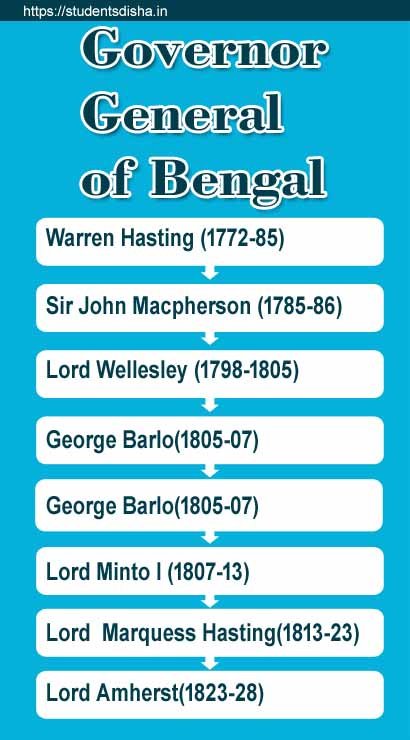Dear Readers, Here I provide all the list of Governor General of Bengal with complete details for Railway NTPC, Group-D, SSC, Banking, State PSU, and all Competitive Examinations. It is one of the important topics in Indian history. Another history topics are Important war/Battle in Indian history
The Governor-General of Bengal was introduced through the Regulating Act, 1773 with his four newly appointed councilors. Governor-General of Bengal to be appointed by the court of Director of the East India Company. The Court of Directors assigned a council of four members to assist the Governor-General and the decision of the council was binding on the Governor-General. A governor represented by the British East India Company in Bengal and granted the right to establish a trading post by the Nawabs of Bengal.
Table of Contents
List of Governor General of Bengal in Indian History are:-
Warren Hasting (1772-85):
- Warren Hasting became Governor of Bengal in 1772 and the first Governor-General of Bengal in 1773 through the Regulating Act, 1773.
- Abolished Dual System Of Administration.
- Established 1st Supreme Court at Calcutta( 22nd Oct 1774)
- The“Asiatic Society of Bengal “founded by him William Jones in 1784.
- Charles Wilkins Translate “The Gita” in English during his period.
- Introduce Diwanis faujdari Adalat.
- “code of Gentoo laws”.
- 1st anglo Maratha war (1776-82) which ended with the treaty of Salbai.
- The 2nd anglo Mysore war (1780-84) ended with the treaty of Mangalore.
- Rohilla war in 1774.
- The act of 1781 came into force, under which the power of jurisdiction between the Governor-General-in-council and the supreme court at Calcutta were clearly divided.
- Pitts India act of 1784 was enacted.
Sir John Macpherson (1785-86):
- Sir John Macpherson was made the acting Governor-General from 1785 to 1786.
Lord Cornwallis (1786-93):
- He called as Father of Indian Civil Services.
- First-person to Codify laws in 1793. The code separated the Revenue administration from the administration of Justice.
- Introduce the Zamindari system in 1773, which also called the Permanent Settlement of Bengal.
- Third Anglo-Mysore war(1789-92) ) which ended with the Treaty of Srirangapatnam.
- He introduces District Judge post
- He was the first Governor-General in India. His grave is in Ghazipur(UP).
Sir John Shore (1793-98):

- He was the first civil servant to become Governor-General.
- The first Charter Act of 1793 was enacted.
- Followed non-intervention Policy with other states/Territories.
- Battle of Kharda in 1795 between Nizam & Maratha.
Lord Wellesley (1798-1805):
- Also called Mornington.
- He was famous as Bengal Tiger.
- Adopted the policy of “Subsidiary Alliance” (1st accepted by Nizam of Hyderabad in 1798,2nd –Nawab of Awadh in 1801).
- He established Fort William College in Calcutta in 1800.
- Fourth Anglo-Mysore war (1799)where Tipu died.
- 2nd Anglo Maratha war (1803-05) which ended with the treaty of Bassein.
- Press Act of 1799 was enacted.
George Barlow(1805-07):
- Adopted the non-Intervention policy with the princely state.
- White Mutiny at Vellore by soldiers in 1806.
Lord Minto I (1807-13):
- Treaty of Amritsar in 1809 with Ranjit Singh.
- Charter Act of 1813 was passed. (Ended Monopoly of East India Company).
Lord Marquess Hasting(1813-23):
- Adopted the Intervention and war policy.
- Ryotwari system settlement introduced in Madras by Thomas Munro.
- The Anglo-Nepal war(1814-16 ) which ended with the Treaty of Sagauli(1815).
- Treaty of Sangali with Gurkhas(1816).
- Treaty of Poona with Peshwa(1817).
Lord Amherst(1823-28):
- Barrackpore mutiny of 1824 happened.
- The Siege of Bharatpur (Dec 1825-Jan 1826) happened.
- 1st Anglo Burmese war (1824-26) which ended with the treaty of Yandabo.
FAQ Governor General of Bengal
Q. Who is the first Governor-General of Bengal?
Ans-Warren Hasting became the first Governor-General of Bengalin 1773 through the Regulating Act, 1773.
Q. Who introduced subsidiary Alliance?
Ans-Lord Wellesley who was the Governor-General of Bengal introduced the subsidiary Alliance.
Q. When Ended Monopoly of East India Company?
Ans- According to the Charter Act of 1813, the Monopoly of East India Company Ended in 1813.
You can read also:
